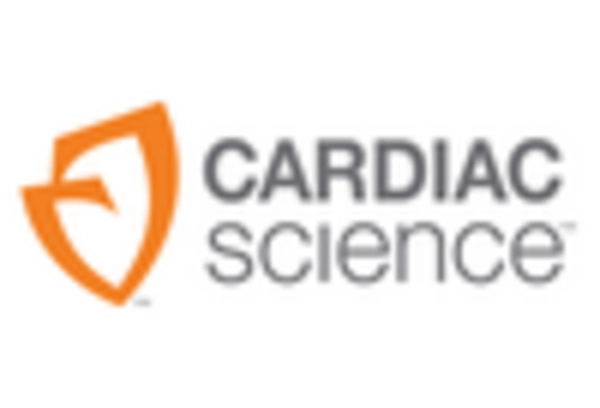Increased Awareness and Training
The Hospital and Pre-Hospital External Defibrillator Market is witnessing a notable increase in awareness regarding cardiac arrest and the importance of immediate defibrillation. Public health campaigns and training programs are being implemented to educate both healthcare professionals and the general public about the use of defibrillators. This heightened awareness is leading to a greater demand for defibrillators in various settings, including schools, workplaces, and public spaces. According to recent statistics, the number of trained individuals in CPR and AED usage has risen significantly, which correlates with an increase in defibrillator sales. This trend is expected to continue, further propelling the market forward.
Regulatory Support and Standards
The Hospital and Pre-Hospital External Defibrillator Market is benefiting from increased regulatory support and the establishment of standards that promote the use of defibrillators in various environments. Regulatory bodies are advocating for the inclusion of defibrillators in public access programs, which is leading to more widespread adoption. Additionally, the development of guidelines for the placement and maintenance of defibrillators in public spaces is enhancing their visibility and availability. This regulatory push is likely to result in a more favorable market environment, encouraging manufacturers to innovate and expand their product offerings. As a consequence, the market is expected to see sustained growth in the coming years.
Rising Incidence of Cardiac Diseases
The Hospital and Pre-Hospital External Defibrillator Market is significantly impacted by the rising incidence of cardiac diseases across various demographics. As lifestyle-related health issues become more prevalent, the demand for effective emergency response tools, such as defibrillators, is increasing. Statistics indicate that cardiovascular diseases remain a leading cause of mortality worldwide, prompting healthcare systems to prioritize the availability of defibrillation devices. This trend is further supported by initiatives aimed at improving emergency response times and outcomes for cardiac arrest patients. Consequently, the market is poised for growth as healthcare providers and institutions recognize the critical role of defibrillators in saving lives.
Demand for Portability and Ease of Use
The Hospital and Pre-Hospital External Defibrillator Market is increasingly influenced by the demand for portable and easy-to-use defibrillators. As emergency medical services strive to provide timely interventions, the need for lightweight and compact devices has become paramount. Manufacturers are responding by designing defibrillators that are not only portable but also user-friendly, allowing for quick deployment in emergency situations. The rise in outdoor activities and sports events has further amplified this demand, as organizations seek to ensure safety measures are in place. Market analysis indicates that portable defibrillators are expected to account for a significant share of the market, reflecting a shift towards more accessible life-saving technologies.
Technological Advancements in Defibrillation
The Hospital and Pre-Hospital External Defibrillator Market is experiencing a surge in technological advancements that enhance the efficacy and usability of defibrillators. Innovations such as automated external defibrillators (AEDs) equipped with advanced algorithms and real-time feedback mechanisms are becoming increasingly prevalent. These devices are designed to analyze heart rhythms and provide voice prompts, making them user-friendly even for untrained bystanders. Furthermore, the integration of connectivity features allows for remote monitoring and data collection, which can be invaluable for healthcare providers. As a result, the market is projected to grow at a compound annual growth rate (CAGR) of approximately 7% over the next five years, driven by these technological improvements.

















Leave a Comment